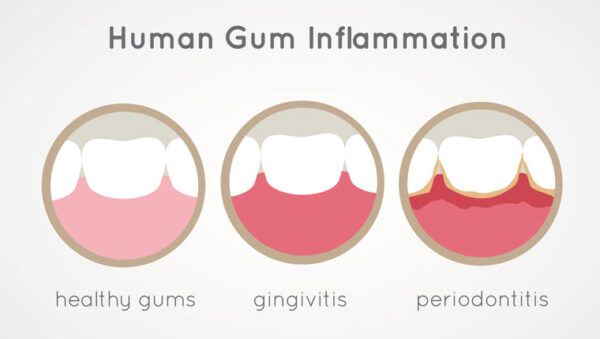Don’t let gum or periodontal disease ruin your smile
Gum Disease
What is gum disease?
Gum disease is described as swelling, soreness or infection of the tissues supporting the teeth. It usually starts as gingivitis and an early warning sign is bleeding when you brush. If it’s left untreated, gingivitis can develop into periodontitis – a more advanced form of gum disease that affects the underlying bone.
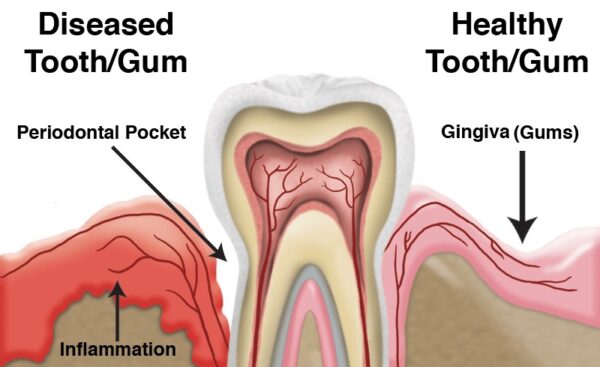
Gingivitis (inflammation of the gums) is a fairly common infection that begins with the bacterial accumulation in the mouth. The build-up of plaque causes gums to become red and swollen and bleed easily. It is often a result of poor oral hygiene, inadequate nutrition and some other medical conditions. When left untreated, gingivitis can progress to Periodontitis.
What is Periodontal disease?
Long-standing gingivitis can turn into periodontal disease. Periodontal disease (Periodontitis) affects not only your gums, but the other structures that support your teeth, including the bone and soft tissues. If periodontitis isn’t treated promptly your gums and bone may recede, which in severe cases can lead to tooth loss.
What are the symptoms of Gum Disease?
It’s really important to spot the early signs of gum disease or gum problems and tackle them before they turn into something more serious. Here’s what to look out for:
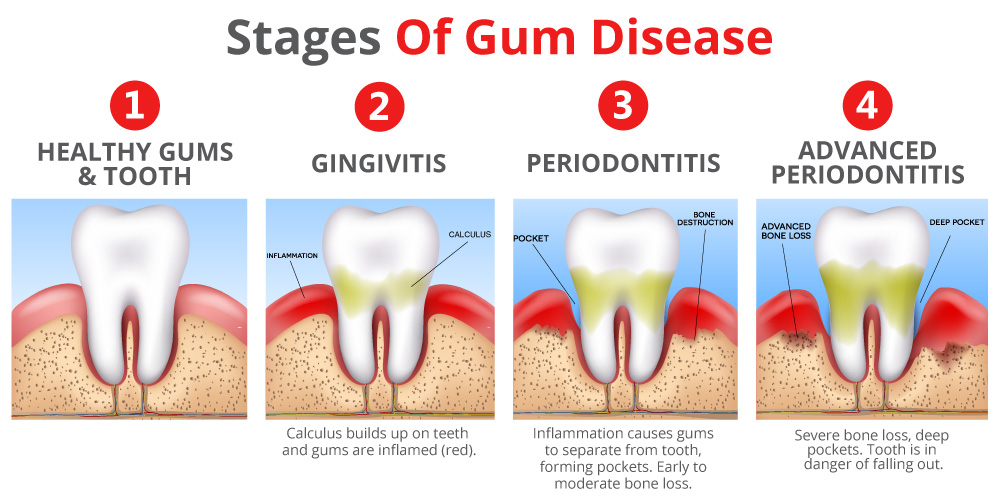
| Early signs of gum disease | Advanced signs of gum disease |
|
|
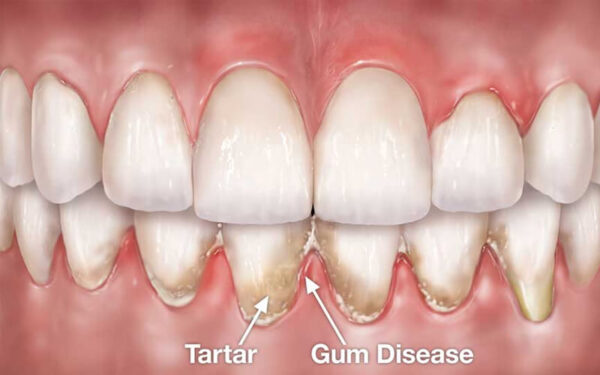
What is the cause of Gum Disease?
All types of gum diseases are caused by plaque. Plaque is a film of bacteria which forms on the surface of the teeth every day. Many of the bacteria in plaque are completely harmless, but there are some that have been shown to be the main cause of gum disease. To prevent and treat gum disease, you need to make sure you remove all the plaque from your teeth every day. This is done by regular brushing of teeth and cleaning in between the teeth with dental floss and inter-dental brushes.
What happens if Gum Disease is not treated?
One of the initial or first sign is blood on your toothbrush or in the toothpaste (bleeding gums) you spit out after cleaning your teeth. Your gums may also bleed when you are eating, leaving a bad taste in your mouth. You may also experience bad breath or unpleasant taste.
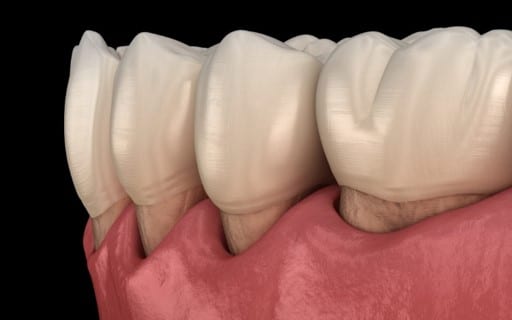
How do I know if I have Gum Disease?
Unfortunately, gum disease or gum infection does not usually cause pain as it gets worse, so you do not notice the damage it is doing. Your gums may begin to form a pocket below the gum line. This pocket traps food and plaque and becomes too deep for you to effectively clean it out by yourself with tooth brushing and flossing. This can lead to gum abscesses, and pus may ooze from around the teeth. Over a number of years, the bone supporting the teeth can be lost. If the disease is left untreated for a long time, treatment can be more difficult.
What are the different Gum Treatment options that may be needed?
Depending on severity, treatment options will vary. In any case the first goal is to gain control of the disease and stop the spread.
- Gum disease is usually caused by a build-up of plaque, which contains bacteria that irritate your gums. For most patients, the early signs of gum disease can be treated by improving their oral hygiene routine and ensuring plaque is effectively removed daily by brushing and flossing and by use of interdental brush.
- When plaque (soft deposit) is left on the teeth it will eventually turn into tartar (hard deposit), also known as calculus. Your dentist will remove all plaque and tartar from your teeth using ultrasonic instruments (Teeth Scaling or Teeth Cleaning).
- If your gum disease is more advanced you will need more proactive treatment by the specialist or periodontist that includes Surgical Options mentioned below:
Flap or Pocket surgery – Periodontal Flap Surgery includes root planning and pocket debridement
Root planning – is a deeper cleaning to get rid of all plaque and calculus (tartar) along the gum line and on the teeth to prevent cavities and gum disease. It is done using curettes, which are hand-held instruments that are curved and tapered to fit around and in between the teeth.
Pocket debridement – this is similar to root planning but more thorough. It includes cleaning the root surface as well as the pocket between your gums and teeth and the underlying tissues.
Soft tissue graft – if gums have receded (gum recession), they can sometimes be ‘rebuilt’ through a gum graft, where tissue is taken from another area to replace what’s been lost.
Bone graft – we can also replace depleted bone by performing a bone graft using bone from a different area of your mouth or body, or synthetic bone.
Guided tissue regeneration – this involves stimulating and guiding the growth of your bone and soft tissues using barrier membranes. These membranes keep the gum tissue and bone separate so they can regrow in the correct proportions.
Tooth Extraction – if a tooth cannot be saved it may be necessary to remove it and replace it with a bridge, dental implant or denture.
Some of these surgical treatments require a local anaesthetic to ensure you don’t experience any discomfort during the dental procedure. Your dentist may also prescribe antibiotics to take during this treatment.
How do I prevent gum disease?
Gingivitis or Gum problems may be prevented or managed using simple preventative measures:
- Brush your teeth and gums two times a day using a soft brush, with a fluoride toothpaste at least for 2 -3 min twice a daily.
- Don’t forget to brush your tongue as well, or use a tongue scraper.
- Clean in between your teeth with interdental brushes or floss at least once a day, ideally before going to bed. Brushing alone only cleans up to about 60 percent of the surface of your teeth.
- Use a soft bristled toothbrush, which is less likely to damage teeth or gums, and don’t brush too hard, which can actually damage teeth.
- Replace your toothbrush every three months, or after illnesses like the flu.
- Minimise your snacking habits especially after dinner and brushing your teeth.
- Chew on sugar free chewing gum, rinse with and drink water regularly, or brush after having snacks.
- Rinse with an effective mouthwash – we don’t recommend the long-term use of mouthwash. We generally recommend mouthwash for up to 2 weeks only
- Avoid sugary foods, tobacco products, and drinking excessive amounts of alcohol.
- Visit your dentist at least once every six months for a routine dental examination, teeth scaling and polishing.
You can enjoy a better quality of life by preventing gum disease. That’s why brushing and flossing is important. Early treatment for gum disease is crucial if you are to avoid tooth loss and the systemic health complications associated with poor gum health.
If you are looking for dentist in Mysore for gum problems like; bleeding gums, bad breath, gum recession etc. contact us or book an appointment at Life Care Dental Clinic Mysore.


